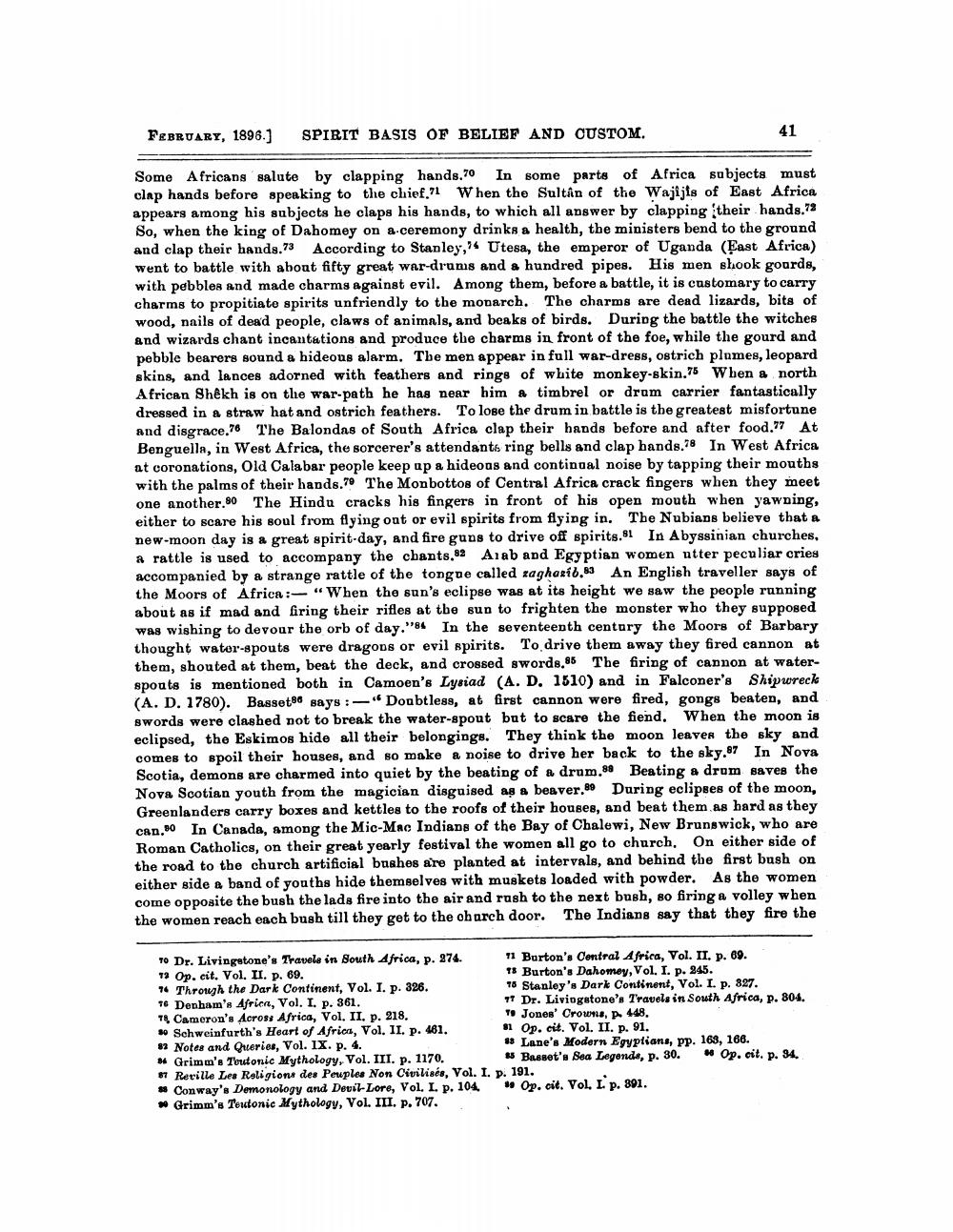________________
FEBRUARY, 1896.)
SPIRIT BASIS OF BELIEF AND CUSTOM.
Some Africans salute by clapping hands.70 In some parts of Africa subjects must clap hands before speaking to the chief. When the Sultan of the Wajijis of East Africa appears among his subjects he claps his hands, to which all answer by clapping their hands.72 So, when the king of Dahomey on a ceremony drinks a health, the ministers bend to the ground and clap their hands.73 According to Stanley," Utesa, the emperor of Uganda (East Africa) went to battle with about fifty great war-drums and a hundred pipes. His men shook gourds, with pebbles and made charms against evil. Among them, before a battle, it is customary to carry charms to propitiate spirits unfriendly to the monarch. The charms are dead lizards, bits of wood, nails of dead people, claws of animals, and beaks of birds. During the battle the witches and wizards chant incantations and produce the charms in front of the foe, while the gourd and pebble bearers sound a hideous alarm. Tbe men appear in full war-dress, ostrich plumes, leopard skins, and lances adorned with feathers and rings of white monkey-skin.75 When a north African Shekh is on the war-path he has near him A timbrel or drum carrier fantastically dressed in a straw hat and ostrich feathers. To lose the drum in battle is the greatest misfortune and disgrace.76 The Balondas of South Africa clap their hands before and after food.77 At Benguella, in West Africa, the sorcerer's attendants ring bells and clap hands.78 In West Africa at coronations, Old Calabar people keep up a hideous and continual noise by tapping their mouths with the palms of their hands. The Monbottos of Central Africa crack fingers when they meet one another.80 The Hindu cracks his fingers in front of his open mouth when yawning, either to scare his soul from flying out or evil spirits from flying in. The Nubians believe that a new-moon day is a great spirit-day, and fire guns to drive off spirits.81 In Abyssinian churches, a rattle is used to accompany the chants.82 Arab and Egyptian women utter peculiar cries accompanied by a strange rattle of the tongue called zagharib.83 An English traveller says of the Moors of Africa : "When the sun's eclipse was at its height we saw the people running about as if mad and firing their rifles at the sun to frighten the monster who they supposed was wishing to devour the orb of day."86 In the seventeenth century the Moors of Barbary thought water-spouts were dragons or evil spirits. To drive them away they fired cannon at them, shouted at them, beat the deck, and crossed swords.85 The firing of cannon at waterspouts is mentioned both in Camoen's Lysiad (A. D. 1510) and in Falconer's Shipwreck (A. D. 1780). Basset86 says: "Doubtless, at first cannon were fired, gongs beaten, and swords were clashed not to break the water-spout but to scare the fiend. When the moon is eclipsed, the Eskimos hide all their belongings. They think the moon leaves the sky and comes to spoil their houses, and so make a noise to drive her back to the sky.87 In Nova Scotia, demons are charmed into quiet by the beating of a drum.88 Beating a drom saves the Nova Scotian youth from the magician disguised as a beaver.89 During eclipses of the moon, Greenlanders carry boxes and kettles to the roofs of their houses, and beat them as hard as they can. In Canada, among the Mic-Mac Indians of the Bay of Chalewi, New Brunswick, who are Roman Catholics, on their great yearly festival the women all go to church. On either side of the road to the church artificial bushes are planted at intervals, and behind the first bush on either side a band of youths hide themselves with muskets loaded with powder. As the women come opposite the bush the lads fire into the air and rush to the next bush, so firing a volley when the women reach each bush till they get to the charch door. The Indians say that they fire the
To Dr. Livingstone's Travels in South Africa, p. 274. 11 Burton's Central Africa, Vol. II. p. 69. 73 Op. cit. Vol. II. p. 69.
13 Burton's Dahomey, Vol. I. p. 245. 76 Through the Dark Continent, Vol. I. p. 326.
16 Stanley's Dark Continent, Vol. I. p. 827. T6 Denham's Africa, Vol. I. p. 361.
7 Dr. Liviogetone's Travels in South Africa, p. 804. T1 Cameron's Across Africa, Vol. II, p. 218.
TJones' Crowns, p. 448. # Schweinfurth's Heart of Africa, Vol. II. p. 461. * Op. cit. Vol. II. p. 91. #2 Notes and Queries, Vol. IX. p. 4.
* Lane's Modern Egyptians, pp. 165, 166. # Grimm's Toudonic Mythology, Vol. III. p. 1170.
* Basset's Sea Legends, p. 30. * Op. cit. p. 34. #7 Reville Les Religion des Peuples Non Civilisés, Vol. I. p. 191. - Conway's Demonology and Deuil-Lore, Vol. I. p. 104 - Op. cit. Vol. L p. 891.
Grimm's Teutonic Mythology, Vol. III. p. 707.




